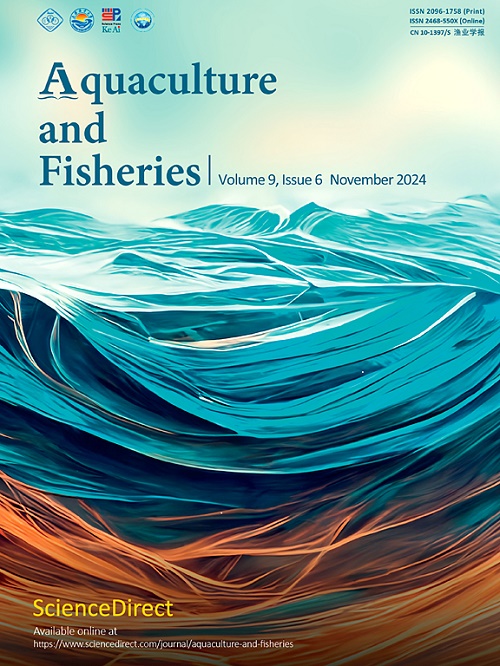越南引起急性肝胰腺坏死病的副溶血性弧菌的特征和多样性
Q1 Agricultural and Biological Sciences
引用次数: 0
摘要
急性肝胰腺坏死病(AHPND)是虾类的一种传染性疾病,死亡率极高,在2009-2016年期间给全球虾类产业造成了估计236亿美元的损失。一种二元毒素,PirAB,是病原体,由通常在副溶血性弧菌中发现的毒性质粒上的pirABvp基因编码。本文从越南湄公河三角洲分离出17株副溶血性弧菌,其中15株含有相同的pirABvp基因。选择pirAB pcr阴性的2株和pirAB阳性的9株进行全基因组测序。多位点序列分型发现了与分离位点相关的5种序列类型(st),其中包括1种新的序列类型。核心基因组最大似然树分析显示,该菌株形成3个聚类,与来自泰国、韩国、中国和菲律宾的菌株亲缘关系密切。所有测序菌株均携带β-内酰胺(包括blaOXA-10和blaNDM-1)和四环素抗性基因,抗性基因范围为3-13个。pirab阳性菌株与典型AHPND毒力质粒具有很大的同源性。综上所述,本研究揭示了越南湄公河三角洲引起ahpnd的菌株的特征,并提出了越南和其他虾养殖国家之间可能的传播途径。本文章由计算机程序翻译,如有差异,请以英文原文为准。
Characteristics and diversity of Vibrio parahaemolyticus causing acute hepatopancreatic necrosis disease in Vietnam
Acute hepatopancreatic necrosis disease (AHPND) is a contagious disease in shrimp with extremely high mortality rate, causing an estimated $23.6 billion loss to the global shrimp industry during 2009–2016. A binary toxin, PirAB, is the causative agent, which is encoded by the pirABvp genes on a virulent plasmid typically found in Vibrio parahaemolyticus. Here, seventeen strains of V. parahaemolyticus were isolated from the Mekong Delta of Vietnam, of which 15 harboured identical pirABvp genes. The remaining two strains, which were PCR-negative for pirAB, and nine positive strains were selected for whole genome sequencing. Multi-locus sequence typing revealed five sequence types (STs), including one novel, that were associated with sites of isolation. A maximum likelihood tree of core genomes revealed that our strains formed three clusters and were closely related to strains from Thailand, South Korea, China, and Philippines. All sequenced strains carried β-lactam (including blaOXA-10 and blaNDM-1) and tetracycline resistance genes, with a range of 3–13 resistance genes. The pirAB-positive strains shared large regions of homology with the prototypical AHPND virulent plasmid. In summary, this work revealed the characteristics of AHPND-causing strains in the Mekong Delta of Vietnam and suggested possible transmission routes among Vietnam and other shrimp farming countries.
求助全文
通过发布文献求助,成功后即可免费获取论文全文。
去求助
来源期刊

Aquaculture and Fisheries
Agricultural and Biological Sciences-Aquatic Science
CiteScore
7.50
自引率
0.00%
发文量
54
审稿时长
48 days
期刊介绍:
 求助内容:
求助内容: 应助结果提醒方式:
应助结果提醒方式:


